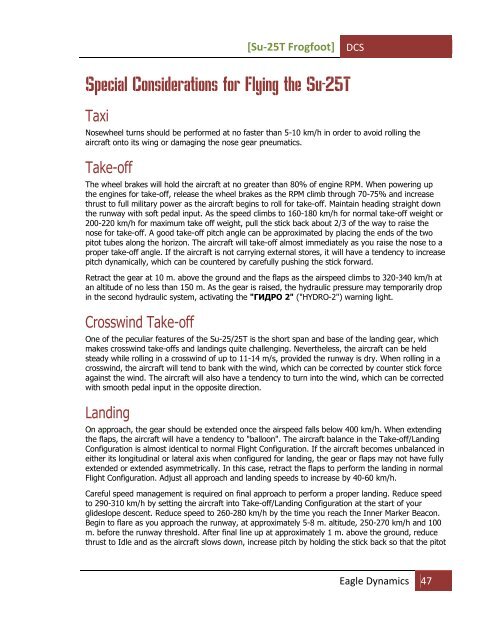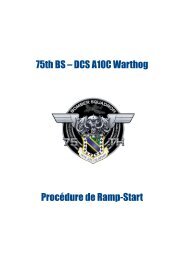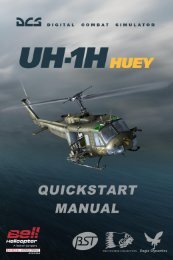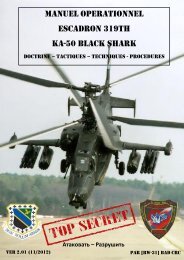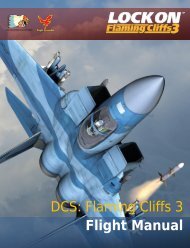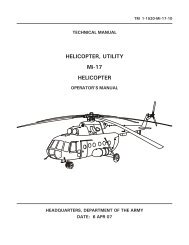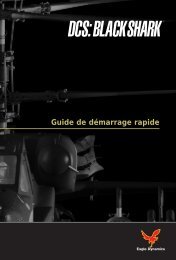You also want an ePaper? Increase the reach of your titles
YUMPU automatically turns print PDFs into web optimized ePapers that Google loves.
[<strong>Su</strong>-<strong>25T</strong> Frogfoot]<br />
<strong>DCS</strong><br />
Special Considerations for Flying the <strong>Su</strong>-<strong>25T</strong><br />
Taxi<br />
Nosewheel turns should be performed at no faster than 5-10 km/h in order to avoid rolling the<br />
aircraft onto its wing or damaging the nose gear pneumatics.<br />
Take-off<br />
The wheel brakes will hold the aircraft at no greater than 80% of engine RPM. When powering up<br />
the engines for take-off, release the wheel brakes as the RPM climb through 70-75% and increase<br />
thrust to full military power as the aircraft begins to roll for take-off. Maintain heading straight down<br />
the runway with soft pedal input. As the speed climbs to 160-180 km/h for normal take-off weight or<br />
200-220 km/h for maximum take off weight, pull the stick back about 2/3 of the way to raise the<br />
nose for take-off. A good take-off pitch angle can be approximated by placing the ends of the two<br />
pitot tubes along the horizon. The aircraft will take-off almost immediately as you raise the nose to a<br />
proper take-off angle. If the aircraft is not carrying external stores, it will have a tendency to increase<br />
pitch dynamically, which can be countered by carefully pushing the stick forward.<br />
Retract the gear at 10 m. above the ground and the flaps as the airspeed climbs to 320-340 km/h at<br />
an altitude of no less than 150 m. As the gear is raised, the hydraulic pressure may temporarily drop<br />
in the second hydraulic system, activating the "ГИДРО 2" ("HYDRO-2") warning light.<br />
Crosswind Take-off<br />
One of the peculiar features of the <strong>Su</strong>-25/<strong>25T</strong> is the short span and base of the landing gear, which<br />
makes crosswind take-offs and landings quite challenging. Nevertheless, the aircraft can be held<br />
steady while rolling in a crosswind of up to 11-14 m/s, provided the runway is dry. When rolling in a<br />
crosswind, the aircraft will tend to bank with the wind, which can be corrected by counter stick force<br />
against the wind. The aircraft will also have a tendency to turn into the wind, which can be corrected<br />
with smooth pedal input in the opposite direction.<br />
Landing<br />
On approach, the gear should be extended once the airspeed falls below 400 km/h. When extending<br />
the flaps, the aircraft will have a tendency to "balloon". The aircraft balance in the Take-off/Landing<br />
Configuration is almost identical to normal <strong>Fli</strong>ght Configuration. If the aircraft becomes unbalanced in<br />
either its longitudinal or lateral axis when configured for landing, the gear or flaps may not have fully<br />
extended or extended asymmetrically. In this case, retract the flaps to perform the landing in normal<br />
<strong>Fli</strong>ght Configuration. Adjust all approach and landing speeds to increase by 40-60 km/h.<br />
Careful speed management is required on final approach to perform a proper landing. Reduce speed<br />
to 290-310 km/h by setting the aircraft into Take-off/Landing Configuration at the start of your<br />
glideslope descent. Reduce speed to 260-280 km/h by the time you reach the Inner Marker Beacon.<br />
Begin to flare as you approach the runway, at approximately 5-8 m. altitude, 250-270 km/h and 100<br />
m. before the runway threshold. After final line up at approximately 1 m. above the ground, reduce<br />
thrust to Idle and as the aircraft slows down, increase pitch by holding the stick back so that the pitot<br />
Eagle Dynamics 47


